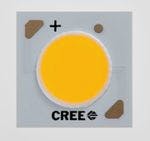Cree has minimally participated in the market for larger LED arrays until now, but has changed that stance with the introduction of the CXA1507/12 and CXA2520/30 arrays that span the range from 500 lm to 5000 lm in output. The company is positioning the arrays as a quick way for solid-state lighting (SSL) manufacturers to get luminaires and retrofit lamps to market while still delivering products with good color quality and efficacy.
Cree presents the CXA arrays as a middle ground between the options of designing an SSL product with discrete LEDs or using a finished modular light engine. The arrays can't match the lower bill of material costs of a design using discrete LEDs, but the engineering cost and development time are significantly reduced.
Some manufacturers refer to the class of products that Cree just announced as chip-on-board (COB) arrays, although Cree isn't using the COB moniker. The four new arrays are packaged on a metal-core boards and come in two sizes. The CXA1507/12 measures 15.85×15.85 mm with a 9-mm light emitting surface (LES) while the CXA2520/30 measures 23.85×23.85 mm with a 23-mm LES.
LES is a new metric defined by the Zhaga Consortium for use in its light engine specifications or books. And the Cree parts match the LES requirements set forth in some of the Zhaga books.
The nearby graphic provides a simple illustration of the breadth of application scenarios in terms of lumen output. Each of the four new components can range significantly in lumen output based on drive current. The lowest-power CXA1507 can yield 550-1000 lm while the highest-power CXA2530 can yield 2000-5000 lm.
The efficacy for the new arrays ranges from 99-108 lm/W at 85°C and nominal drive current. All require a forward voltage in the 36V to 37V range. Cree product marketing manager Paul Scheidt said that the forward voltage in that range was preferred globally as companies make SSL products that can be sold in different regions around the globe with different AC line voltage.
Cree already has a reference design of a PAR30 retrofit lamp that illustrates the use of the arrays. The lamp produces 900 lm using 16W, and delivering efficacy of 42 lm/W. That reference design uses the CXA1507 array at 3000K and with a CRI or 80. The lamp uses an off-the-shelf reflector from optics specialist Illumination Machines.
Scheidt also provided a comparison of the new Cree components with competitive arrays. He said that the CXA1512 could deliver 1227 lm in a PAR38 at an efficacy of 70 lm/W. He said the competition could only match that with arrays with 14- to 19-mm LES as opposed to the 9-mm Cree part.
Cree also believes that it has delivered a superior mechanical design. Scheidt pointed out large accessible solder pads, and a significant buffer zone between the pads and the actual array that provides room for an optic to be tightly installed around the array.
The four new components are available in color temperatures ranging from 2700-5000K. Cree is optionally offering the components with a CRI of 90, and in 2-step MacAdam ellipse bins based on the EasyWhite color mixing technology.
Product development teams that want to use the arrays can design their own mounting scheme, or turn to connectors from Molex, TE Connectivity and Mekoda Optical that are purpose built for the arrays. Those connectors would also accelerate the design cycle.
As is typical when Cree announces a new LED, the company already has customers. "We switched to Cree’s new CXA1507 LED Array because it delivers higher performance over other LED Arrays," said Jason Lee, president of Gama Illuminer. “The easy-to-use package of the CXA1507 LED Array with well-designed features and small optical source made design and manufacturing simple."








